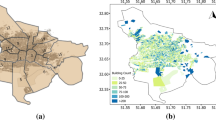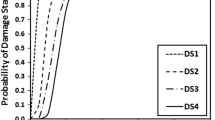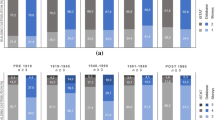Abstract
Community-scale estimates of building damage and economic loss are modeled for Seaside, Oregon, for Cascadia subduction zone events ranging from 8.7 to 9.3 MW with corresponding slip distances of 3–25 m considering only the effects of the tsunami. Numerical simulations are obtained from the National Oceanic and Atmospheric Administration’s method of splitting tsunami model which includes a source model, subsidence, and calculations of the propagation and inundation flow characteristics. The damage estimates are based on fragility curves from the literature which relate flow depth with probability of damage for two different structural materials of buildings. Calculations are performed at the parcel level for the inundation hazard without including damage caused by the earthquake itself. Calculations show that the severity of building damage in Seaside is sensitive to the magnitude of the event or degree of slip because the majority of the city is located on low-lying coastal land within the estimated inundation zone. For the events modeled, the percentage of building within the inundation zone ranges from 9 to 88 %, with average direct economic losses ranging from $2 million to $1.2 billion.















Similar content being viewed by others
References
Cox D, Tomita T, Lynett P, Holman RA (2008) Kinematics of breaking tsunami wavefronts: a data set from large scale laboratory experiments. In: Proceeding 31st international conference on coastal engineering. ASCE, pp 1421–1432
Cercone C, Naito C, Riggs R, Cox D (2013) Tsunami generated debris and structural performance guidelines. J Waterway Port Coastal Ocean Eng
CREW (Cascadia Region Earthquake Workgroup) (2013) Cascadia subduction zone earthquakes: a magnitude 9.0 earthquake scenario. Oregon department of Geology and Mineral Industries Open File Report O-05-05
Delouis B, Nocquet JM, Vallée M (2010) Slip distribution of the February 27, 2010 Mw = 8.8 Maule Earthquake, central Chile, from static and high-rate GPS, InSAR, and broadband teleseismic data. Geophys Res Lett
Dominey-Howes D, Dunbar P, Varner J, Papathoma-Kohle M (2010) Estimating probable maximum loss from a Cascadia tsunami. Nat Hazards 53:43–61
FEMA P646 (2008) Guidelines for design of structures for vertical evacuation from tsunamis. Federal Emergency Management Agency, Washington
Gica E, Spillane MC, Titov VV, Chamberlin CD, Newman JC (2008) Development of the forecast propagation database for NOAA’s short-term inundation forecast for tsunamis (SIFT): NOAA Technical Memorandum OAR PMEL-139. Pacific Marine Environmental Laboratory, Seattle
Goldfinger C, Nelson CH, Morey AE, Johnson JE, Patton JR, Karabanov E et al (2012) Turbidite event history—methods and implications for holocene paleoseismicity of the Cascadia subduction zone. U.S. Geological Survey Professional Paper 1661–F, 170 p
Gonzalez FI, Geist EL, Jaffe B, Kanoglu U, Mofjeld H, Synolakis CE et al (2009) Probabilistic tsunami hazard assessment at Seaside, Oregon, for near- and far-field seismic sources. J Geophys Res 114:1–19
Hirata K, Satake K, Tanioka Y, Kuragano T, Hasegawa Y, Hayashi Y et al. (2006) The 2004 Indian Ocean tsunami: tsunami source model from satellite altimetry. Earth Planets Space 195–2001
Ichinose G, Somerville P, Thio HK, Graves R, O’Connell D (2007) Rupture process of the 1964 Prince William Sound, Alaska, earthquake from the combined inversion of seismic, tsunami, and geodetic data. J Geophys Res
Kaiser G, Scheele L, Kortenhaus A, Lovholt F, Romer H, Leschka S (2011) The influence of land cover roughness on the results of high resolution tsunami inundation modeling. Nat Hazards Earth Syst Sci 11:2521–2540
Koshimura S, Oie T, Yanagisawa H, Imanura F (2009) Developing fragility functions for tsunami damage estimation using numerical model and post-tsunami data from Banda Aceh, Indonesia. Coast Eng J 51:243–273
Mori N, Takahashi T, Yasuda T, Yanagisawa H (2011) Survey of 2011 Tohoku earthquake tsunami inundation and run-up. Geophys Res Lett 38
Muhari A, Imanura F, Koshimura S, Post J (2011) Examination of three practical run-up models for assessing tsunami impact on highly populated areas. Nat Hazards Earth Syst Sci 11:3107–3123
Murao O, Nakazato H (2010) Vulnerability functions for buildings based on damage survey data in Sri Lanka after the 2004 Indian Ocean tsunami. International conference on sustainable built environment, pp 371–378
National Tsunami Hazard Mitigation Program (2012) Proceedings and Results of the 2011 NTHMP Model Benchmarking Workshop. Boulder, CO: Department of Commerce/NOAA/NTHMP; (NOAA Special Report). 436 p
Okada Y (1985) Surface deformation due to shear and tensile faults in a half-space. Bull Seismolog Soc Am 75(4):1135–1154
Park S, van de Lindt JW, Cox DT, Gupta R, Aguiniga A (2012) Successive earthquake-tsunami analysis to develop collapse fragilities. J Earthq Eng 16:851–863
Park H, Lynett PJ, Cox DT, Wiebe DM, Shin S (2013) Tsunami inundation modeling in constructed environments: a physical and numerical comparison of free-surface elevation, velocity, and momentum flux. Coast Eng
PMEL (2006) Method of splitting tsunami (MOST) software manual. NOAA
PMEL. Community Model Interface for Tsunami (ComMIT). NOAA
Rueben M, Holman R, Cox D, Shin S, Killian J, Stanley J (2011) Optical measurements of tsunami inundation through an urban waterfront modeled in a large-scale laboratory basin. Coast Eng 58:229–238
Satake K, Wang K, Atwater BF (2003) Fault slip and seismic moment of the 1700 Cascadia earthquake inferred from Japanese tsunami descriptions. J Geophys Res
Schultz MT, Gouldby BP, Simm JD, Wibowo JL (2010) Beyond the Factor of Safety: Developing Fragility Curves to Characterize System Reliability SR-10-1. US army corps of engineers: engineering research and development center
Shoji G, Moriyama T (2007) Evaluation of the structural fragility of a bridge structure subjected to a tsunami wave load. J Nat Disaster Sci 29:73–81
Suppasri A, Imamura F, Koshimura S (2010) Effect of the rupture velocity of fault motion, ocean current and initial sea level on the transoceanic propagation of tsunami. Coast Engineering Journal 52(2):107–132
Suppasri A, Koshimura S, Imamura F (2011) Developing tsunami fragility curves based on the satellite remote sensing and the numerical modeling of the 2004 Indian Ocean tsunami in Thailand. Nat Hazards Earth Syst Sci 11:173–189
Suppasri, A., Mas, E., Koshimura, S., Imai, K., Harada, K., & Imamura, F. (2012). Developing tsunami fragility curves from the surveyed data of the 2011 Great East Japan tsunami in Sendai and Ishinomaki plains. Coast Eng J
Suppasri A, Mas E, Charvet I, Gunasekera R, Imai K, Fukutani Y et al. (2013) Building damage characteristics based on surveyed data and fragility curves of the 2011 Great East Japan tsunami. Nat Hazards 319–341
Tang L, Titov VV, Chamberlin CD (2009) Development, testing, and applications of site-specific tsunami inundation models for real-time forecasting. J Geophys Res 114:C12
Titov VV, Synolakis CE (1995) Modeling of breaking and nonbreaking long wave evolution. J Waterway Port Coast Ocean Eng 121(6):308–316
Titov VV, Synolakis CE (1998) Numerical modeling of tidal wave runup. J Waterway Port Coast Ocean Eng 124(4):157–171
Titov VV, Moore CW, Greenslade DJ, Pattiaratchi C, Badal R, Synolakis CE et al (2011) New tool for inundation modeling: community modeling interface for tsunamis (ComMIT). Pure Appl Geophys 168:2121–2131
Tsunami Pilot Study Working Group (2006) Seaside, Oregon, Tsunami Pilot Study—Modernization of FEMA Flood Hazard Maps. Joint NOAA/USGS/FEMA Special Report 94
Wood N (2007) Variations in city exposure and sensitivity to tsunami hazards in Oregon. U.S. Geological Survey Scientific Investigations Report 2007-5283
Yanagisawa H, Koshimura S, Goto K, Miyagi T, Imamura F, Ruangrassamee A et al (2009) The reduction effects of mangrove forest on a tsunami based on field surveys at Pakarang Cape, Thailand and numerical analysis. Estuar Coast Shelf Sci 81:27–37
Yeh H, Robertson I, Preuss J (2005) Development of design guidelines for structures that serve as tsunami vertical evacuation sites. Washington Division of Geology and Earth Resources, Olympia: Open File Report 2005-4.
Yoshida Y, Ueno H, Muto D, Aoki S (2011) Source process of the 2011 off the Pacific coast of Tohoku Earthquake with the combination of teleseismic and strong motion data. Earth Planets Space 63:565–569
Acknowledgments
This project was supported by Oregon Sea Grant (R/CNH-22). The authors would like to thank the two anonymous reviewers for their comments and suggestions to improve the manuscript.
Author information
Authors and Affiliations
Corresponding author
Rights and permissions
About this article
Cite this article
Wiebe, D.M., Cox, D.T. Application of fragility curves to estimate building damage and economic loss at a community scale: a case study of Seaside, Oregon. Nat Hazards 71, 2043–2061 (2014). https://doi.org/10.1007/s11069-013-0995-1
Received:
Accepted:
Published:
Issue Date:
DOI: https://doi.org/10.1007/s11069-013-0995-1




